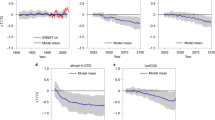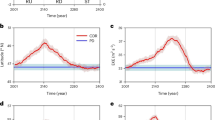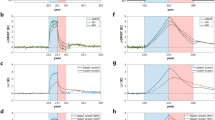Abstract
With the unprecedented rate of global warming in recent decades, whether or not anthropogenic climate change is irreversible is an important question. Based on idealized CO2 ramp-up until 1,468 ppm and symmetric ramp-down model experiments, here we show that the intertropical convergence zone (ITCZ) does not respond linearly to CO2 forcing, but exhibits strong hysteresis behaviour. While the location of the ITCZ changes minimally during the ramp-up period, it moves sharply south as soon as CO2 begins to decrease, and its centre eventually resides in the Southern Hemisphere during the ramp-down period. Such ITCZ hysteresis is associated with delays in global energy exchanges between the tropics and extratropics. The delayed energy exchanges are explained by two distinct hysteresis behaviours of the Atlantic Meridional Overturning Circulation and slower warming/cooling in the Southern Ocean. We also suggest that the ITCZ hysteresis can lead to hysteresis in regional hydrological cycles.
This is a preview of subscription content, access via your institution
Access options
Access Nature and 54 other Nature Portfolio journals
Get Nature+, our best-value online-access subscription
$29.99 / 30 days
cancel any time
Subscribe to this journal
Receive 12 print issues and online access
$209.00 per year
only $17.42 per issue
Buy this article
- Purchase on Springer Link
- Instant access to full article PDF
Prices may be subject to local taxes which are calculated during checkout




Similar content being viewed by others
Data availability
The data used in this study are available from https://doi.org/10.6084/m9.figshare.1666932461, and the CMIP6 archives are freely available from https://esgf-node.llnl.gov/projects/cmip6.
Code availability
The code used in this study is available from the corresponding author on reasonable request.
References
Joos, F. & Spahni, R. Rates of change in natural and anthropogenic radiative forcing over the past 20,000 years. Proc. Natl Acad. Sci. USA 105, 1425–1430 (2008).
Swingedouw, D. et al. Early warning from space for a few key tipping points in physical, biological, and social-ecological systems. Surv. Geophys. 41, 1237–1284 (2020).
Lenton, T. M. Early warning of climate tipping points. Nat. Clim. Chang. 1, 201–209 (2011).
Lenton, T. M. et al. Tipping elements in the Earth’s climate system. Proc. Natl Acad. Sci. USA 105, 1786–1793 (2008).
Miller, G. H. et al. Abrupt onset of the Little Ice Age triggered by volcanism and sustained by sea-ice/ocean feedbacks. Geophys. Res. Lett. 39, L02708 (2012).
Broecker, W. S. Unpleasant surprises in the greenhouse? Nature 328, 123–126 (1987).
Jeltsch-Thömmes, A., Stocker, T. F. & Joos, F. Hysteresis of the Earth system under positive and negative CO2 emissions. Environ. Res. Lett. 15, 124026 (2020).
Wu, P., Wood, R., Ridley, J. & Lowe, J. Temporary acceleration of the hydrological cycle in response to a CO2 rampdown. Geophys. Res. Lett. 37, L12705 (2010).
Sgubin, G., Swingedouw, D., Drijfhout, S., Hagemann, S. & Robertson, E. Multimodel analysis on the response of the AMOC under an increase of radiative forcing and its symmetrical reversal. Clim. Dyn. 45, 1429–1450 (2015).
Cao, L., Bala, G. & Caldeira, K. Why is there a short-term increase in global precipitation in response to diminished CO2 forcing? Geophys. Res. Lett. 38, 1–6 (2011).
Gillett, N. P., Arora, V. K., Zickfeld, K., Marshall, S. J. & Merryfield, W. J. Ongoing climate change following a complete cessation of carbon dioxide emissions. Nat. Geosci. 4, 83–87 (2011).
Chadwick, R., Wu, P., Good, P. & Andrews, T. Asymmetries in tropical rainfall and circulation patterns in idealised CO2 removal experiments. Clim. Dyn. 40, 295–316 (2013).
Lowe, J. A. et al. How difficult is it to recover from dangerous levels of global warming? Environ. Res. Lett. 4, 014012 (2009).
Frölicher, T. L. & Joos, F. Reversible and irreversible impacts of greenhouse gas emissions in multi-century projections with the NCAR global coupled carbon cycle-climate model. Clim. Dyn. 35, 1439–1459 (2010).
Boucher, O. et al. Reversibility in an Earth system model in response to CO2 concentration changes. Environ. Res. Lett. 7, 024013 (2012).
Wu, P., Ridley, J., Pardaens, A., Levine, R. & Lowe, J. The reversibility of CO2 induced climate change. Clim. Dyn. 45, 745–754 (2015).
Garbe, J., Albrecht, T., Levermann, A., Donges, J. F. & Winkelmann, R. The hysteresis of the Antarctic Ice Sheet. Nature 585, 538–544 (2020).
Kang, S. M., Shin, Y. & Xie, S. P. Extratropical forcing and tropical rainfall distribution: energetics framework and ocean Ekman advection. npj Clim. Atmos. Sci. 1, 20172 (2018).
Su, H. et al. Tightening of tropical ascent and high clouds key to precipitation change in a warmer climate. Nat. Commun. 8, 1–9 (2017).
Byrne, M. P. & Schneider, T. Atmospheric dynamics feedback: concept, simulations, and climate implications. J. Clim. 31, 3249–3264 (2018).
Kang, S. M., Held, I. M., Frierson, D. M. W. & Zhao, M. The response of the ITCZ to extratropical thermal forcing: idealized slab-ocean experiments with a GCM. J. Clim. 21, 3521–3532 (2008).
Kang, S. M., Frierson, D. M. W. & Held, I. M. The tropical response to extratropical thermal forcing in an idealized GCM: the importance of radiative feedbacks and convective parameterization. J. Atmos. Sci. 66, 2812–2827 (2009).
Frierson, D. M. W. & Hwang, Y. T. Extratropical influence on ITCZ shifts in slab ocean simulations of global warming. J. Clim. 25, 720–733 (2012).
Donohoe, A., Marshall, J., Ferreira, D. & Mcgee, D. The relationship between ITCZ location and cross-equatorial atmospheric heat transport: from the seasonal cycle to the last glacial maximum. J. Clim. 26, 3597–3618 (2013).
Donohoe, A., Marshall, J., Ferreira, D., Armour, K. & Mcgee, D. The interannual variability of tropical precipitation and interhemispheric energy transport. J. Clim. 27, 3377–3392 (2014).
Bischoff, T. & Schneider, T. The equatorial energy balance, ITCZ position, and double-ITCZ bifurcations. J. Clim. 29, 2997–3013 (2016).
Byrne, M. P. & Schneider, T. Narrowing of the ITCZ in a warming climate: physical mechanisms. Geophys. Res. Lett. 43, 11,350–11,357 (2016).
Byrne, M. P. & Schneider, T. Energetic constraints on the width of the intertropical convergence zone. J. Clim. 29, 4709–4721 (2016).
Byrne, M. P., Pendergrass, A. G., Rapp, A. D. & Wodzicki, K. R. Response of the intertropical convergence zone to climate change: location, width, and strength. Curr. Clim. Chang. Rep. 4, 355–370 (2018).
Chou, C., Neelin, J. D., Chen, C. A. & Tu, J. Y. Evaluating the ‘rich-get-richer’ mechanism in tropical precipitation change under global warming. J. Clim. 22, 1982–2005 (2009).
Atwood, A. R., Donohoe, A., Battisti, D. S ., Liu, X. & Pausata, F. S. R. Robust longitudinally variable responses of the ITCZ to a myriad of climate forcings. Geophys. Res. Lett. 47, e2020GL088833 (2020).
Mamalakis, A. et al. Zonally contrasting shifts of the tropical rain belt in response to climate change. Nat. Clim. Chang. 11, 143–151 (2021).
Moreno-Chamarro, E., Marshall, J. & Delworth, T. L. Linking ITCZ migrations to the AMOC and North Atlantic/Pacific SST decadal variability. J. Clim. 33, 893–905 (2020).
Lau, W. K. M. & Kim, K. M. Robust Hadley circulation changes and increasing global dryness due to CO2 warming from CMIP5 model projections. Proc. Natl Acad. Sci. USA 112, 3630–3635 (2015).
Liu, Z., Vavrus, S., He, F., Wen, N. & Zhong, Y. Rethinking tropical ocean response to global warming: the enhanced equatorial warming. J. Clim. 18, 4684–4700 (2005).
Zhou, W., Xie, S. P. & Yang, D. Enhanced equatorial warming causes deep-tropical contraction and subtropical monsoon shift. Nat. Clim. Chang. 9, 834–839 (2019).
Lee, S.-Y., Chiang, J. C. H., Matsumoto, K. & Tokos, K. S. Southern Ocean wind response to North Atlantic cooling and the rise in atmospheric CO2: modeling perspective and paleoceanographic implications. Paleoceanography 26, PA1214 (2011).
Liu, W., Fedorov, A. V., Xie, S. P. & Hu, S. Climate impacts of a weakened Atlantic Meridional Overturning Circulation in a warming climate. Sci. Adv. https://doi.org/10.1126/sciadv.aaz4876 (2020).
Cvijanovic, I. & Chiang, J. C. H. Global energy budget changes to high latitude North Atlantic cooling and the tropical ITCZ response. Clim. Dyn. 40, 1435–1452 (2013).
Eyring, V. et al. Overview of the Coupled Model Intercomparison Project Phase 6 (CMIP6) experimental design and organization. Geosci. Model Dev. 9, 1937–1958 (2016).
Schneider, T., Bischoff, T. & Haug, G. H. Migrations and dynamics of the intertropical convergence zone. Nature 513, 45–53 (2014).
Friedman, A. R., Hwang, Y. T., Chiang, J. C. H. & Frierson, D. M. W. Interhemispheric temperature asymmetry over the twentieth century and in future projections. J. Clim. 26, 5419–5433 (2013).
Chiang, J. C. H. & Bitz, C. M. Influence of high latitude ice cover on the marine intertropical convergence zone. Clim. Dyn. 25, 477–496 (2005).
Bischoff, T. & Schneider, T. Energetic constraints on the position of the intertropical convergence zone. J. Clim. 27, 4937–4951 (2014).
Wei, H. H. & Bordoni, S. Energetic constraints on the ITCZ position in idealized simulations with a seasonal cycle. J. Adv. Model. Earth Syst. 10, 1708–1725 (2018).
White, R. H. et al. Tropical precipitation and cross-equatorial heat transport in response to localized heating: basin and hemisphere dependence. Geophys. Res. Lett. 45, 11,949–11,958 (2018).
Marshall, J., Donohoe, A., Ferreira, D. & McGee, D. The ocean’s role in setting the mean position of the inter-tropical convergence zone. Clim. Dyn. 42, 1967–1979 (2014).
Jackson, L. C. Shutdown and recovery of the AMOC in a coupled global climate model: the role of the advective feedback. Geophys. Res. Lett. 40, 1182–1188 (2013).
Haskins, R. K., Oliver, K. I. C., Jackson, L. C., Wood, R. A. & Drijfhout, S. S. Temperature domination of AMOC weakening due to freshwater hosing in two GCMs. Clim. Dyn. 54, 273–286 (2020).
Levang, S. J. & Schmitt, R. W. What causes the AMOC to weaken in CMIP5? J. Clim. 33, 1535–1545 (2020).
Thorpe, R. B., Gregory, J. M., Johns, T. C., Wood, R. A. & Mitchell, J. F. B. Mechanisms determining the Atlantic Thermohaline Circulation response to greenhouse gas forcing in a non-flux-adjusted coupled climate model. J. Clim. 14, 3102–3116 (2001).
Held, I. M. et al. Probing the fast and slow components of global warming by returning abruptly to preindustrial forcing. J. Clim. 23, 2418–2427 (2010).
Long, S.-M., Xie, S.-P., Zheng, X.-T. & Liu, Q. Fast and slow responses to global warming: sea surface temperature and precipitation patterns. J. Clim. 27, 285–299 (2014).
Hoskins, B. J. & Karoly, D. J. The steady linear response of a spherical atmosphere to thermal and orographic forcing. J. Atmos. Sci. 38, 1179–1196 (1981).
Taylor, K. E., Stouffer, R. J. & Meehl, G. A. An overview of CMIP5 and the experiment design. Bull. Am. Meteorol. Soc. 93, 485–498 (2012).
Hurrell, J. W. et al. The community earth system model: a framework for collaborative research. Bull. Am. Meteorol. Soc. 94, 1339–1360 (2013).
Meinshausen, M. et al. The Shared Socio-economic Pathway (SSP) greenhouse gas concentrations and their extensions to 2500. Geosci. Model Dev. 13, 3571–3605 (2020).
Keller, D. P. et al. The Carbon Dioxide Removal Model Intercomparison Project (CDRMIP): rationale and experimental protocol for CMIP6. Geosci. Model Dev. 11, 1133–1160 (2018).
Guo, L. et al. The contributions of local and remote atmospheric moisture fluxes to East Asian precipitation and its variability. Clim. Dyn. 51, 4139–4156 (2018).
Fasullo, J. T. & Trenberth, K. E. The annual cycle of the energy budget. Part I: global mean and land–ocean exchanges. J. Clim. 21, 2297–2312 (2008).
Kug, J.-S. et al. Data for hysteresis of the intertropical convergence zone to CO2 forcing. Figshare https://doi.org/10.6084/m9.figshare.16669324 (2021)
Acknowledgements
This work was supported by the National Research Foundation of Korea (NRF-2018R1A5A1024958), the National Supercomputing Center with supercomputing resources including technical support (KSC-2018-CHA-0062) and the Korea Research Environment Open NETwork (KREONET).
Author information
Authors and Affiliations
Contributions
J.-H.O. compiled the data, conducted analyses, prepared the figures and wrote the manuscript. J.-S.K. designed the research and wrote the majority of the manuscript content. All of the authors discussed the study results and reviewed the manuscript.
Corresponding author
Ethics declarations
Competing interests
The authors declare no competing interests.
Additional information
Peer review information Nature Climate Change thanks Antonios Mamalakis, Didier Swingedouw and the other, anonymous, reviewer(s) for their contribution to the peer review of this work.
Publisher’s note Springer Nature remains neutral with regard to jurisdictional claims in published maps and institutional affiliations.
Extended data
Extended Data Fig. 1 Time evolution of the ITCZ width, northern and southern edge of the ITCZ.
Time series of a, ITCZ width, b, northern edge and c, southern edge of ITCZ. ITCZ edge is defined as the latitude that is changed from a zonal-mean upward motion to a downward motion in the mid-troposphere (700hPa). Lines and shadings as in Fig. 1b.
Extended Data Fig. 2 Precipitation anomalies in the extreme El Niño period.
Composite of DJF averaged precipitation anomalies during 82/83, 97/98, and 15/16 El Niño period in the observational data, b, during the cases when the DJF Nino3.4 index is greater than the 2standard deviation of the DJF Nino3.4 index in the model (CESM1). The observational precipitation data are the Climate Prediction Merged Analysis of Precipitation (CMAP), which uses a horizontal resolution of 2.5° and covers the period from 1979 to 2018. Note that the seasonal cycle and linear trend are removed from the data.
Extended Data Fig. 3 Changes in global hydrological cycle in CMIP6.
Same as Fig. 2c, but the data from the individual models in CMIP6 (ACCESS-ESM1-5, CanESM5, CESM2, GFDL-ESM4, MIROC-ES2L, UKESM1-0-LL).
Extended Data Fig. 4 Changes in global SAT and hydrological cycle in CMIP6.
Same as Fig. 2a and d-e, but the data in the multi-model mean from the CMIP6 (ACCESS-ESM1-5, CanESM5, CESM2, GFDL-ESM4, MIROC-ES2L, UKESM1-0-LL). The regions denoted by the cross-shaped dots a, dots b, and colors c, indicate where more than 2/3 of models disagree a, agree b, and agree c with the sign of the multi-model mean, respectively.
Extended Data Fig. 5 Changes in poleward ocean heat transport.
Time-series of the AMOC strength, global poleward ocean heat transport at 30°N and 30°S, b, poleward ocean heat transport anomalies at 30°N in global, Atlantic, and Indo-Pacific oceans relative to the Year 2000. The ocean heat transport variable (N_HEAT; both global and Atlantic components are included) is obtained directly from the model output. Note that the heat transport at 30°S is the absolute value. Lines and shadings as in Fig. 1b.
Extended Data Fig. 6 Land and ocean contribution to global surface warming.
The percentage of the land and ocean SAT anomalies in the NH and SH for global surface temperature anomaly relative to long-term climatological values of the present climate simulation. Dotted lines represent the ratio of each area to the total earth surface (SH ocean: 40.5%, SH land: 9.5%, NH ocean: 30.2%, NH land: 19.8%). Solid line indicates the boundary of SH land and NH ocean, which represent hemispheric warming contrast. For example, less than 50% of the solid line means that the NH is warmer than the SH. b, The deviation of the percentage of each component from the ratio to the total earth surface (deonted in Dotted lines in a). c, Time-series of the top 2000m ocean heat content anomaly integrated over the Southern Ocean (90°S–50°S) relative to the Year 2000. Lines and shadings as in Fig. 1b.
Rights and permissions
About this article
Cite this article
Kug, JS., Oh, JH., An, SI. et al. Hysteresis of the intertropical convergence zone to CO2 forcing. Nat. Clim. Chang. 12, 47–53 (2022). https://doi.org/10.1038/s41558-021-01211-6
Received:
Accepted:
Published:
Issue Date:
DOI: https://doi.org/10.1038/s41558-021-01211-6
This article is cited by
-
Hemispheric asymmetric response of tropical cyclones to CO2 emission reduction
npj Climate and Atmospheric Science (2024)
-
Asymmetric hysteresis response of mid-latitude storm tracks to CO2 removal
Nature Climate Change (2024)
-
Emergent climate change patterns originating from deep ocean warming in climate mitigation scenarios
Nature Climate Change (2024)
-
CAS-ESM2.0 Dataset for the Carbon Dioxide Removal Model Intercomparison Project (CDRMIP)
Advances in Atmospheric Sciences (2024)
-
Irreversible loss in marine ecosystem habitability after a temperature overshoot
Communications Earth & Environment (2023)



